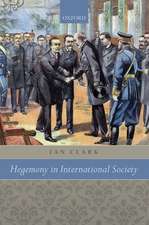The New US Strategy towards Asia: Adapting to the American Pivot: Routledge Security in Asia Pacific Series
Editat de William T Tow, Douglas Stuarten Limba Engleză Hardback – 6 ian 2015
| Toate formatele și edițiile | Preț | Express |
|---|---|---|
| Paperback (1) | 198.19 lei 6-8 săpt. | |
| Taylor & Francis – 28 noi 2017 | 198.19 lei 6-8 săpt. | |
| Hardback (1) | 390.37 lei 6-8 săpt. | |
| Taylor & Francis – 6 ian 2015 | 390.37 lei 6-8 săpt. |
Din seria Routledge Security in Asia Pacific Series
-
 Preț: 326.36 lei
Preț: 326.36 lei - 18%
 Preț: 1165.73 lei
Preț: 1165.73 lei -
 Preț: 387.49 lei
Preț: 387.49 lei - 26%
 Preț: 821.87 lei
Preț: 821.87 lei -
 Preț: 411.85 lei
Preț: 411.85 lei -
 Preț: 466.29 lei
Preț: 466.29 lei - 18%
 Preț: 1167.71 lei
Preț: 1167.71 lei -
 Preț: 132.04 lei
Preț: 132.04 lei - 18%
 Preț: 1002.99 lei
Preț: 1002.99 lei -
 Preț: 261.75 lei
Preț: 261.75 lei -
 Preț: 476.60 lei
Preț: 476.60 lei -
 Preț: 485.32 lei
Preț: 485.32 lei - 12%
 Preț: 325.34 lei
Preț: 325.34 lei -
 Preț: 412.74 lei
Preț: 412.74 lei -
 Preț: 491.26 lei
Preț: 491.26 lei - 17%
 Preț: 271.61 lei
Preț: 271.61 lei - 18%
 Preț: 736.24 lei
Preț: 736.24 lei -
 Preț: 260.07 lei
Preț: 260.07 lei -
 Preț: 282.69 lei
Preț: 282.69 lei - 18%
 Preț: 1053.92 lei
Preț: 1053.92 lei -
 Preț: 484.47 lei
Preț: 484.47 lei -
 Preț: 467.44 lei
Preț: 467.44 lei -
 Preț: 463.58 lei
Preț: 463.58 lei -
 Preț: 471.25 lei
Preț: 471.25 lei - 18%
 Preț: 1227.03 lei
Preț: 1227.03 lei -
 Preț: 450.03 lei
Preț: 450.03 lei -
 Preț: 316.83 lei
Preț: 316.83 lei -
 Preț: 343.91 lei
Preț: 343.91 lei -
 Preț: 389.66 lei
Preț: 389.66 lei - 18%
 Preț: 1002.63 lei
Preț: 1002.63 lei - 43%
 Preț: 214.23 lei
Preț: 214.23 lei - 18%
 Preț: 1162.84 lei
Preț: 1162.84 lei - 18%
 Preț: 1060.52 lei
Preț: 1060.52 lei
Preț: 390.37 lei
Nou
Puncte Express: 586
Preț estimativ în valută:
74.70€ • 77.06$ • 62.34£
74.70€ • 77.06$ • 62.34£
Carte tipărită la comandă
Livrare economică 27 martie-10 aprilie
Preluare comenzi: 021 569.72.76
Specificații
ISBN-13: 9781138822634
ISBN-10: 1138822639
Pagini: 236
Dimensiuni: 156 x 234 x 18 mm
Greutate: 0.48 kg
Ediția:1
Editura: Taylor & Francis
Colecția Routledge
Seria Routledge Security in Asia Pacific Series
Locul publicării:Oxford, United Kingdom
ISBN-10: 1138822639
Pagini: 236
Dimensiuni: 156 x 234 x 18 mm
Greutate: 0.48 kg
Ediția:1
Editura: Taylor & Francis
Colecția Routledge
Seria Routledge Security in Asia Pacific Series
Locul publicării:Oxford, United Kingdom
Public țintă
PostgraduateCuprins
Preface 1. Setting the Context Part 1: Asia’s Place in America’s Global Strategy 2. Obama’s "Rebalance" in Historical Context 3. Rebalancing and Order-building: Strategy or Illusion? 4. Deterrence, the Twenty-First Century, and the "Pivot" Part 2: Northeast Asian Partners and Allies 5. US Rebalancing to the Asia-Pacific: A Japanese Perspective 6. South Korea’s Adaptation to the US Pivot to Asia 7. The US Pivot to Asia: Taiwan’s Security Challenges and Responses Part 3: Southeast Asian Partners and Allies 8. Strategic Communication: US–Philippines Relations and the American Rebalancing Strategy 9. A Reluctant Ally? Thailand in the US Rebalancing Strategy 10. Security and Power Balancing: Singapore’s Response to the US Rebalance to Asia Part 4: The Wider Indo-Pacific Region 11. Australia Responds to America’s Rebalance 12. New Zealand’s Response 13. India and the US "Pivot" to Asia: Convergence without Change 14. Balancing the Risks of US Rebalancing
Recenzii
"It should be applauded for its synthesis of history and political science and the interweaving and application of international relations theory to the military and geopolitical dimensions in the wider Asia-Pacific region. Students and scholars in the fields of International History and Relations and Security Studies will receive a comprehensive picture and in-depth analysis to navigate the complexity of the many actors, interests and structural challenges in the Pacific of the 21st century."
Dr. Moritz Pöllath, History Department, Ludwig Maximilian University, Munich, Germany
Dr. Moritz Pöllath, History Department, Ludwig Maximilian University, Munich, Germany
Descriere
Barack Obama’s "rebalancing strategy" or "pivot strategy", intended to demonstrate continued US commitment to the Asia Pacific region in a variety of military, economic and diplomatic contexts, was launched with much fanfare in 2011. Implicit in the new strategy is a focus on China and also a US relience on existing regional allies to implement its strategy. This book explores the impact of the new strategy on the US’s allies in the region, and the allies’ responses. Overall, the book outlines the deep complexities of the United States’ exercise of power and influence in the region.
















